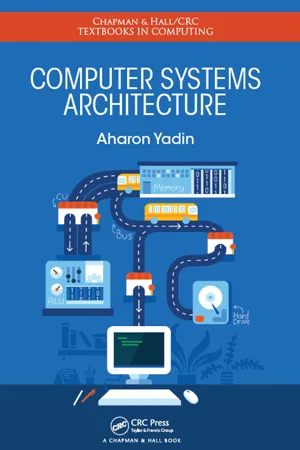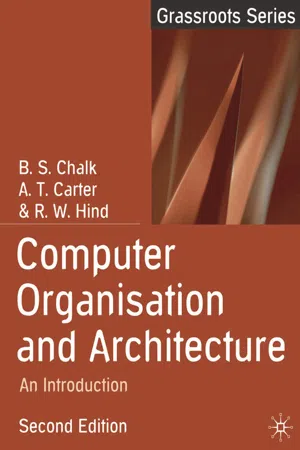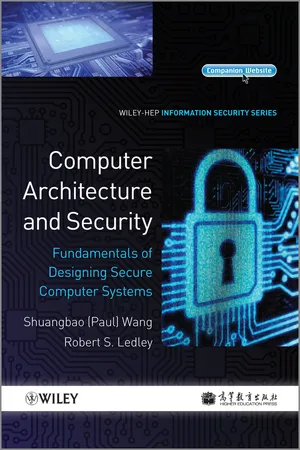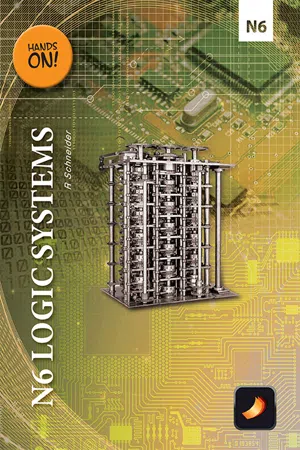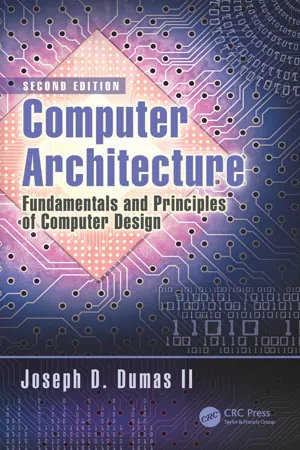Computer Science
CPU Registers
CPU registers are small, high-speed storage locations within the CPU that hold data temporarily during processing. They are used to store instructions, memory addresses, and data for arithmetic operations. Registers are essential for the efficient execution of instructions and play a crucial role in the overall performance of the CPU.
Written by Perlego with AI-assistance
Related key terms
1 of 5
11 Key excerpts on "CPU Registers"
- eBook - PDF
- Aharon Yadin(Author)
- 2016(Publication Date)
- Chapman and Hall/CRC(Publisher)
Most high-level programming languages do not provide this capability and using the registers is left for the compiler only. Registers The idea of using registers was borne from the need to increase the speed of computers. Since even in the early days of computers, there was a need to overcome the architectural 98 ◾ Computer Systems Architecture built-in problem of the processor being significantly faster than the memory. For execut-ing each instruction, the CU has to bring it and its operands from memory. This means that even the very fast processors will have to wait for the operands to be fetched from the relatively slow memory. Since most of the instructions use operands, the memory access became a significant limiting factor to speed. Over the years, various approaches were sug-gested to overcome this problem, such as read ahead , in which the CU reads the instruc-tion that will be required in the near future (this will be elaborated as part of this chapter), or the introduction of cache memory ( Chapter 6 , “Cache Memory”), but the original and effective method was the implementation of registers. A register is a very fast small memory that resides in the processor. By providing a very short access time to the information stored in the register, it speeds the execution of the program. In a sense, the registers resemble the human short-term memory. Like the short-term memory, registers have a fast access time, they are limited in space, and are used only for temporary data. Due to their speed, registers are considered as the top of the memory hierarchy (this term will be explained and elaborated in the next two chapters). Originally, the registers were developed in order to support the hardware operations; today’s mod-ern processors are using many registers as part of their normal operations. For example, every system should have an internal register (sometimes called program counter [PC]) that holds the address of the next instruction to be executed. - eBook - ePub
- Aharon Yadin(Author)
- 2016(Publication Date)
- Chapman and Hall/CRC(Publisher)
Chapter 1 ). It should be noted that as part of software abstraction, accessing registers is available only by using the assembly language. Most high-level programming languages do not provide this capability and using the registers is left for the compiler only.RegistersThe idea of using registers was borne from the need to increase the speed of computers. Since even in the early days of computers, there was a need to overcome the architectural built-in problem of the processor being significantly faster than the memory. For executing each instruction, the CU has to bring it and its operands from memory. This means that even the very fast processors will have to wait for the operands to be fetched from the relatively slow memory. Since most of the instructions use operands, the memory access became a significant limiting factor to speed. Over the years, various approaches were suggested to overcome this problem, such as read ahead, in which the CU reads the instruction that will be required in the near future (this will be elaborated as part of this chapter), or the introduction of cache memory (Chapter 6 , “Cache Memory”), but the original and effective method was the implementation of registers.FIGURE 4.1 The CPU as part of the system.A register is a very fast small memory that resides in the processor. By providing a very short access time to the information stored in the register, it speeds the execution of the program. In a sense, the registers resemble the human short-term memory. Like the short-term memory, registers have a fast access time, they are limited in space, and are used only for temporary data. Due to their speed, registers are considered as the top of the memory hierarchy (this term will be explained and elaborated in the next two chapters). Originally, the registers were developed in order to support the hardware operations; today’s modern processors are using many registers as part of their normal operations. For example, every system should have an internal register (sometimes called program counter [PC]) that holds the address of the next instruction to be executed. When the CU has to fetch the next instruction for execution, it checks the PC to determine the address of that instruction. The PC can be seen as the queue number display often used by various service organizations. This register is maintained by the hardware and the software (applications or operating system) cannot modify it, although its content is changing according to the software behavior. For example, every loop in any application has a conditional branch* - eBook - PDF
Computer Organisation and Architecture
An Introduction
- B.S. Chalk, Antony Carter, Robert Hind(Authors)
- 2017(Publication Date)
- Red Globe Press(Publisher)
A register is a memory location within the processor. A is the name we have given to a general purpose register within the processor. Such registers are sometimes referred to as accumulators . The Memory Address Register (MAR) holds data going on to the address bus. The Memory Buffer Register (MBR) holds data going to/from the data bus. IR is the Instruction Register . This holds the instruction currently being executed. The Arithmetic and Logic Unit is called ALU for short. The status of the last ALU operation is held in the Flags register . The Flags register is often called the Condition Code Register . 4 Central processor unit operation 43 4.2 Processor–Memory interconnection A program consists of a series of instructions or actions to be carried out by the processor. These actions are performed on data. Instructions and data are stored in primary, or main, memory during program execution. In Figure 4.1, instructions and data occupy various memory locations, each location being identified by a unique address . The code in Figure 4.1 will cause a value to be read, or loaded, from memory location 4 into the accumulator in the CPU. A second value will then be read from memory location 5 and added to the first. Finally the result, currently in the accumulator, will be written back, or stored, in memory location 6. 4.2.1 Fetching instructions When running a program, the processor fetches instructions by providing an address on the address bus and reading the instruction from the data bus. To carry out this task, the processor uses a number of internal registers. A register is a small high-speed memory location used for the temporary storage of data or control information. The registers are connected together by an internal data path or bus . The flow of data along this bus is managed by the Control Unit (CU). To understand the purpose of these registers, we will examine how the first instruction in the program, move 4, is fetched. - eBook - ePub
Computer Architecture and Security
Fundamentals of Designing Secure Computer Systems
- Shuangbao Paul Wang, Robert S. Ledley(Authors)
- 2012(Publication Date)
- Wiley(Publisher)
Segment registers – The six 16-bit segment registers contain segment pointers for use in accessing memory. These registers are referenced by the names CS, DS, SS, ES, FS, and GS.- EFLAGS register – This 32-bit is used to provide status and control for basic arithmetic, compare, and system operations.
- EIP register – This 32-bit register contains the current instruction pointer.
General-purpose instructions operate on the following data types. The width of valid data types is dependent on processor mode:- Bytes, words, doublewords
- Signed and unsigned byte, word, doubleword integers
- Near and far pointers
- Bit fields
- BCD integers.
6.2 Registers
Registers are designed for specific functions and are wired specifically for different purposes. A processor contains a number of registers to hold instruction and data. Some special registers are used to store the status of the current operation. Registers are the fastest memory in a computer system. The reason to use registers is to make the computation and handling fast. By reducing the times to access internal and external memories, the RISC machines usually contain a large number of registers to improve the speed.Processors usually assign special roles to certain registers, including these registers:- An Accumulator (ACC), which collects the result of computations (von Neumann, 2006).
- Address Registers, which keep track of where a given instruction or piece of data is stored in memory. Each storage location in memory is identified by an address.
- Data Registers, which temporarily hold data taken from or about to be sent to memory.
- Status Registers, which are used for store current CPU status.
- Program Counter (PC), which is used to point to the current instruction being executed.
Intel Core i7-900 is based on 45 ns process technology. It contains an Execute Disable Bit that allows memory to be marked as executable or non-executable, when combined with a supporting operating system. - Hesham El-Rewini, Mostafa Abd-El-Barr(Authors)
- 2005(Publication Date)
- Wiley-Interscience(Publisher)
In Sec- tion 5.3, we will understand what is meant by datapath and control. CPU instruction cycle and the control unit will be covered in Sections 5.4 and 5.5, respectively. 5.2. REGISTER SET Registers are essentially extremely fast memory locations within the CPU that are used to create and store the results of CPU operations and other calculations. Differ- ent computers have different register sets. They differ in the number of registers, reg- ister types, and the length of each register. They also differ in the usage of each register. General-purpose registers can be used for multiple purposes and assigned to a variety of functions by the programmer. Special-purpose registers are restricted to only specific functions. In some cases, some registers are used only to hold data and cannot be used in the calculations of operand addresses. The length of a data register must be long enough to hold values of most data types. Some machines allow two contiguous registers to hold double-length values. Address registers may be dedicated to a particular addressing mode or may be used as address general purpose. Address registers must be long enough to hold the largest address. The number of registers in a particular architecture affects the instruction set design. A very small number of registers may result in an increase in memory references. Another type of registers is used to hold processor status bits, or flags. These bits are set by the CPU as the result of the execution of an operation. The status bits can be tested at a later time as part of another operation. 5.2.1. Memory Access Registers Two registers are essential in memory write and read operations: the memory data register (MDR) and memory address register (MAR). The MDR and MAR are used exclusively by the CPU and are not directly accessible to programmers. In order to perform a write operation into a specified memory location, the MDR and MAR are used as follows: 1.- eBook - ePub
Programming for Problem-solving with C
Formulating algorithms for complex problems (English Edition)
- Dr. Kamaldeep(Author)
- 2023(Publication Date)
- BPB Publications(Publisher)
NOT , and so on.CUThe control unit serves as the computer’s nervous system. It generates control signals that manage and control all computer components. For example, to add two numbers, it performs the following operation:- Fetches (retrieves) the numbers to be added from memory.
- Fetches the instruction from memory (the instruction is addition in this case).
- Decodes the instruction.
- Asks the ALU to operate as per the instruction.
- Stores the final result in memory.
The registers are the small-sized, quickly accessible memory within the CPU. It consists of a small amount of fast memory. The size of the registers is measured by the number of bits it can hold, for example, 8-bit register, 16-bit register, 32-bit register, 64-bit register, and so on. A computer with a large register can process more information and vice versa. Registers can be grouped into two groups, which are as follows:- General Purpose Registers (GPR ): GPR can hold data and addresses. A data register can hold data, and an address register can hold an address. A GPR is a register that can hold both.
- Special Purpose Register (SPR ): SPR is the register meant for some special purpose. Generally, they hold the state of the program. Some of SPR are as follows:
- Program Counter (PC) Register : The address of the next instruction to be executed is stored in the PC.
- Memory Address Registers (MAR) : This register stores the address of the memory region from which data is retrieved or stored.
- Memory Data Register (MDR) : It works as a buffer between memory and CPU.
- Accumulator (AC) : It interacts with ALU and stores input/output results.
- Instruction Register (IR) : It holds the current instruction being executed.
A computer’s primary function is to run a program (set of instructions). The format of the instruction is shown in Figure 2.1 - eBook - PDF
- R Schneider(Author)
- 2014(Publication Date)
- Future Managers(Publisher)
7 MODULE Central Processing Unit Architecture 7.1 Introduction The central processing unit shown in figure 7.1, consists of the following interconnected units: • Internal Registers • Arithmetic and Logic Unit • Control Unit. Arithetic Logic Unit (ALU) Register Control Unit Fig. 7.1 Basic CPU Architecture The above three interconnected units make up the ‘core’ of the processor. The purpose of each of the units in the processor is: 1. the registers - used for temporary storage of instructions, addresses and data, 2. the arithmetic logic unit (ALU) - to perform various arithmetic and logic functions and 3. the control unit - to accept signals (e.g. interrupt requests), generate control signals and provide timing signals for the entire computer system. Register Set Registers A register set of the 8085 CPU from INTEL, is shown in figure 7.2. Some registers are dedicated types that are used for specific functions, while others are for general use. In considering the register array in figure 7.2, we see that the array consists of both 8 Bit and 16 Bit registers. Register Pairs Registers can either be used on their own or used as a pair with one of the other registers. In the 8085 CPU, the register pairs are: Register Pair High-Order Register Low-Order Register BC B C DE D E HL H L Table 7.1 Register Pairs Module 7 • Central Processing Unit Architecture 112 8-Bit Internal Data Bus Register Array B Reg (8) D Reg (8) H Reg (8) C Reg (8) E Reg (8) L Reg (8) Stack Pointer (16) Program Counter (16) Incrementer Decrementer Address Latch (16) Address Buffer (8) A15-A8 Address Bus Data Address Buffer (8) AD1-AD0 Address Bus Fig. 7.2 Register Set - INTEL 8085, 8 Bit CPU If the general purpose resisters in the register array are each 8 Bits wide, then the register pairs formed by these registers will be 16 Bits wide, as seen in figure 7.2. - eBook - PDF
- Palmer, Greg Tomsho(Authors)
- 2016(Publication Date)
- Cengage Learning EMEA(Publisher)
All Rights Reserved. May not be copied, scanned, or duplicated, in whole or in part. WCN 02-300 After a high-level language program is compiled to assembly language, another step called assembly is needed before it can be executed by the CPU. Assembly translates assembly code into machine code. With machine code, each assembly language statement is translated into a series of numbers — for example, the statement load R1, X might be translated to something like 09 101 2215. Remember, computers can only interpret numeric values; the software they run translates numbers into human-readable form, and vice versa. • Number and usage of registers — As mentioned, a register is a temporary holding loca-tion on a CPU where data must be placed before the CPU can use it. Because so much room is used for microcode on CISC CPUs, there are far fewer registers than on a RISC chip, which doesn ’ t use microcode. The more registers there are, the more simul-taneous operations the CPU can perform, as you saw with pipelining. One of the rea-sons pipelining is easier with RISC CPUs is because there are more registers to store data for pipelined instructions. In addition, CISC CPUs erase their registers after each instruction and require them to be reloaded with each successive instruction, whereas RISC CPUs can leave data in registers until the register is needed for another operation. CISC and RISC CPUs continue to be produced. The debate between which is better is muddied by the inc lusion of CISC features in RISC CPUs and RISC features in CISC CPUs. Intel processors are still considered to be CISC. Speed The speed of a CPU defines how fast it can perform operations. There are many ways to indicate speed, but the most frequently used indicator is the internal clock speed of the CPU. As you may know, a CPU runs on a very rigid schedule along with the rest of the computer. The clock provides this schedule to make sure that all the chips know what to expect at a given time. - eBook - PDF
- Stephen D. Burd(Author)
- 2015(Publication Date)
- Cengage Learning EMEA(Publisher)
Within limits, increasing the number of general-purpose registers decreases program execution time. The CPU uses special-purpose registers to track the status of the CPU and the currently executing program. Important special-purpose registers include the instruction register, instruction pointer, and program status word. • Word size is the number of bits a CPU can process simultaneously. Within limits, CPU ef-ficiency increases with word size because inefficient piece-by-piece operations on large data items are avoided. For optimal performance, other computer system components, such as the system bus, should match or exceed CPU word size. • Techniques to enhance processor performance include pipelining, branch prediction, specu-lative execution, and multiprocessing. Pipelining improves performance by allowing multiple instructions to execute simultaneously in different stages. Branch prediction and speculative execution ensure that the pipeline is kept full while executing conditional BRANCH instruc-tions. Multiprocessing provides multiple CPUs for simultaneous execution of different pro-cesses or programs. • CPUs are electrical devices implemented as silicon-based microprocessors. Like all electri-cal devices, they’re subject to basic laws and limitations of electricity, including conductivity, resistance, heat generation, and speed as a function of circuit length. Microprocessors use a small circuit size, low-resistance materials, and heat dissipation to ensure fast and reliable operation. They’re fabricated by using expensive processes based on ultraviolet or laser etching and chemical deposition. These processes, and semiconductors themselves, are Copyright 2016 Cengage Learning. All Rights Reserved. May not be copied, scanned, or duplicated, in whole or in part. Due to electronic rights, some third party content may be suppressed from the eBook and/or eChapter(s). - eBook - PDF
- Greg Tomsho(Author)
- 2020(Publication Date)
- Cengage Learning EMEA(Publisher)
CPU Design We will discuss different design types of CPUs and various components of a CPU, but before we do, let’s take a look at its basic architecture. Most CPUs are composed of the following elements (see Figure 3-2): • Control unit—The control unit (CU) is the director of operations in the CPU. The control unit provides timing and coordination between the other parts of the CPU, such as the arithmetic logic unit, registers, and system bus. For example, when a new instruction should be executed, the control unit receives and decodes the instruction and tells the arithmetic logic unit to execute it. • Arithmetic logic unit—The arithmetic logic unit (ALU) performs the primary task of any CPU, which is to execute instructions. These might be arithmetic instructions, such as addition or multiplication of integers, or logic instructions, such as binary AND or binary OR instructions. Most CPUs also contain a floating-point unit (FPU) that performs floating-point operations. • Registers—A register is a temporary holding location on a CPU where data must be placed before the CPU can use it. There are instruction registers that hold the instruction the CPU executes, such as add, multiply, or store. Also, the CPU uses address registers to access data stored in RAM and data registers that hold the data the CPU is currently working with, such as two numbers used in an add or multiply instruction. MODULE 3 The Central Processing Unit (CPU) 114 Copyright 2021 Cengage Learning. All Rights Reserved. May not be copied, scanned, or duplicated, in whole or in part. Due to electronic rights, some third party content may be suppressed from the eBook and/or eChapter(s). Editorial review has deemed that any suppressed content does not materially affect the overall learning experience. Cengage Learning reserves the right to remove additional content at any time if subsequent rights restrictions require it. - eBook - PDF
Computer Architecture
Fundamentals and Principles of Computer Design, Second Edition
- Joseph D. Dumas II(Author)
- 2016(Publication Date)
- CRC Press(Publisher)
chapter three Basics of the central processing unit The central processing unit (CPU) is the brain of any computer system based on the von Neumann (Princeton) or Harvard architectures intro-duced in Chapter 1. Parallel machines have many such brains, but normally each of them is based on the same principles used to design the CPU in a uniprocessor (single CPU) system. A typical CPU has three major parts: the arithmetic/logic unit (ALU), which performs calculations; internal reg-isters, which provide temporary storage for data to be used in calculations; and the control unit, which directs and sequences all operations of the ALU and registers as well as the rest of the machine. (A block diagram of a simple CPU is shown in Figure 3.1.) The control unit that is responsible for carrying out the sequential execution of the stored program in memory is the hallmark of the von Neumann–type machine, using the registers and the arithmetic and logical circuits (together known as the datapath ) to do the work. The design of the control unit and datapath have a major impact on the performance of the processor and its suitability for various types of applications. CPU design is a critical component of overall system design. In this chapter, we look at important basic aspects of the design of a typical general-purpose processor; in the following chapter, we will go beyond the basics and look at modern techniques for improving CPU performance. 3.1 The instruction set One of the most important features of any machine’s architectural design, yet one of the least appreciated by many computing professionals, is its instruction set architecture (ISA). The ISA determines how all software must be structured at the machine level.
Index pages curate the most relevant extracts from our library of academic textbooks. They’ve been created using an in-house natural language model (NLM), each adding context and meaning to key research topics.

